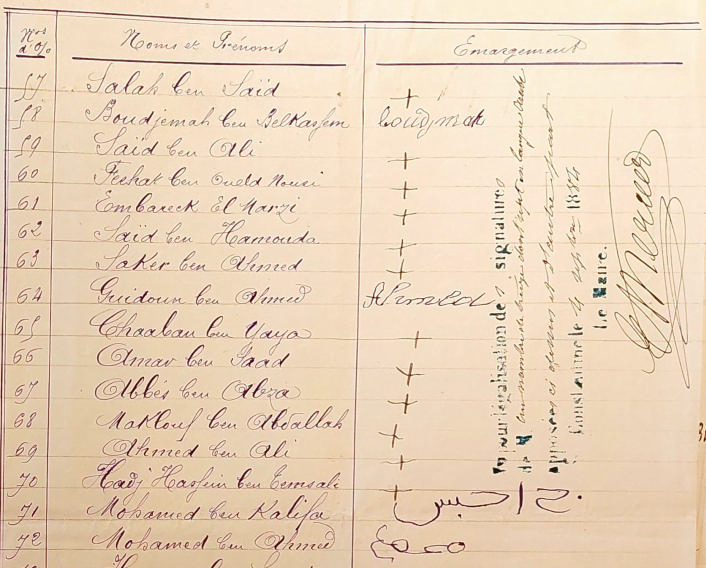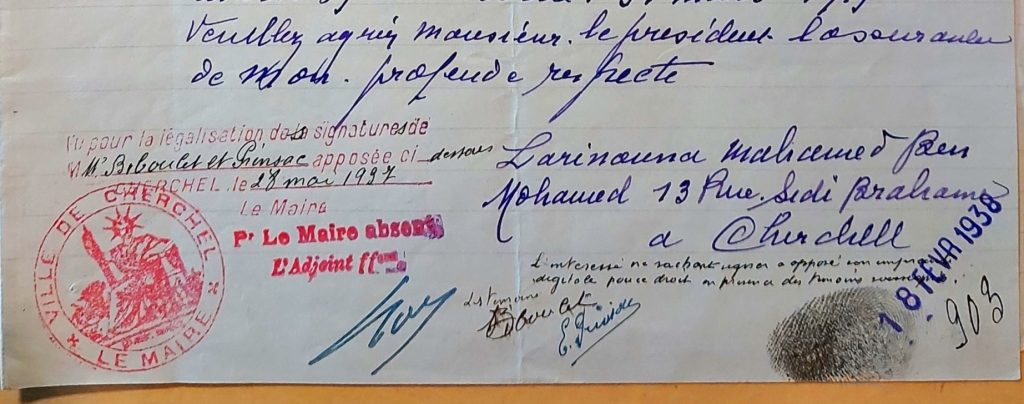Figure 1. René Magritte’s The Treachery of Images (This is Not a Pipe), 1929, copyright free image from Wikimedia Commons, next to document labels (from the 1870s and 1930s), photographed by the author at the French National Archives, which denied that the folders contained “petitions, properly speaking.”
The title of this blogpost parodies the name of one of René Magritte’s most famous paintings called The Treachery of Images, which, underneath its hyperrealist rendition of a pipe denies it being a pipe (Ceci n’est pas une pipe). During my research at the French National Archives, I noticed parallels between the apophatic dialectic of this painting – which visually represents what it contests in writing – and the internal logic of the series of petitions that I was studying. As a theory, apophasis merely affirms the undefinable nature of the subject at hand, but as a speech mode, it also performs this ineffability, as explained by Michael A. Sells (1994, p.3). The author or discussant, who is aware of this issue, speaks a subject into being while negating its very existence. Via this “tension between saying and unsaying,” they thus actively destabilize and reframe earlier certainties. Going beyond speech and text, it is worth investigating such a tension in the materiality of historical archives, especially if not the archivists but historical actors themselves had been responsible for creating such paradoxical dynamics. Among the thousands of letters sent to the French Third Republican Chamber of Deputies (1870–1940), the ones labelled by the assembly’s clerks as not being petitions, or as incoherent, unintelligible, or uncertified ones, deserve particular attention.
But first, what is a petition? This seems to be an easy question with a straightforward answer, and the French parliamentary administrators of my studied era would probably share this impression. The “right to petition” was simply a natural one, accessible to French nationals and outsiders alike, regardless of their suffrage status. France’s colonized Algerian populations, too, had been familiar with the practice of sending requests and complaints to authorities long before their incorporation into the French Third Republic. Although the legislators of that regime did not feel the need to embed the “right to petition” into the Constitution, they did confirm and formally organize its rules within the framework of parliament’s internal regulations (via the law of 22 July 1879). Although these rules remained virtually unchanged for several decades, their enactment was more dynamic in practice, to the point where the archives containing acknowledged and discarded petitions can even be called apophatic.
To be qualified as one worthy of the Committee of Petitions’ attention, a plea (supplique) submitted to the Palais Bourbon needed to be addressed, in writing, to the chairman of the assembly, and contain an “authentic” signature of one or more “supplicants.” A stamp and signature provided by the letter-writer’s (vice-)mayor (cf. Figure 2) or the signatures of two of his trustees, acting as eyewitnesses of the signing (cf. Figure 3), could confirm such “authenticity.” A petition was also valid when a parliamentary representative (député) or a Senator acted as an intermediary by passing the request on to the Chamber’s administration. Sending letters to individual députés was indeed a popular practice in the Third Republic, although not necessarily as a steppingstone toward parliamentary agenda-setting. “Ordinary” Frenchmen and -women seem to have experienced a close connection to “their” representatives in parliament. However, among the many personal and financial issues that they discussed in their early-twentieth-century private correspondence, the majority was not intended for the Chamber’s public eyes (cf. Lauwers 2022).

Figure 2. This close-up is part of a mass petition from 1884, requesting retirement equalization for officers and soldiers. The mayor of Constantine only authenticated the 13 signatures (7 of which were in Arabic), while ignoring the crosses of the illiterate signers on this list containing 87 names of retired officers and soldiers from Constantine, cf. Petition no. 2115, signed on 04-09-1884, registered on 15-11-1884, French National Archives, C//4377.
As French nationals without the French nationality, living in a colony that was politically and administratively incorporated into the French Interior since 1871, Algerian Muslims did not have the same connection with the députés appointed for their region in parliament. Those deputies mostly represented the French settlers and the nationalized Jewish population in the Northern departments of Algeria. That explains why the practice of petitioning to parliament persisted longer among the Muslim population, in their attempt to make the Chamber and the Minister of the Interior aware of the injustices that they were facing. Local and regional tensions undoubtedly complicated the Algerian petitioners’ opportunity to get their signatures (or crosses or thumbprints) certified according to the assembly’s rules on authentication. Yet, an astounding number of letters – the majority of which do not count as “mass petitions” since they rather focused on the issues of one person, family, or smaller community – still managed to catch the attention of the parliamentary Committee of Petitions.
When we count the hundreds of letters sent to the Palais Bourbon from within the Algerian colony, among the hundreds to thousands of petitions sent in total each legislative cycle between the late-1890s and the late-1920s, we can even see a steep and steady increase from 7,16% in the legislative cycle from 1893 to 1898 up to about one-third throughout the entire second half of the 1920s. Together, these percentages account for a few thousand petitions from Algeria among which the relative number of native Muslim letter-writers increased to an overwhelming majority, while the proportion of French settlers decreased. Seemingly without any incentive, the total number of registered petitions dropped to 244 for the legislative cycle between June 1932 and May 1936, with only 40 letters coming from within Algeria.
This sudden decline has led to scholarly indifference about the practice beyond the early twentieth century, and even beyond the early nineteenth, given the introduction of “universal” (yet male-only) suffrage in 1848. In such “democratic” times, so the argument goes, the need to write letters to parliament diminished significantly, causing the practice of petitioning to phase out. The first issue with this line of argument lies in its equation of democracy with voting rights, which were highly exclusionary for the entire duration of the Third Republic. The second issue is its confusion between absence and apophasis, or between archival silence and historical silencing, the latter of which is still visible in the preserved material patterns of saying and unsaying. The minorities or outsiders without French citizenship did not suddenly stop petitioning by the 1930s. The parliamentary administrators just redefined and tightened their application of the formal criteria of a petition without officially amending these criteria. Strangely, the ignored letters from the 1930s looked similar in form and content to the ones that the previous administrations accepted and forwarded to Committees or Ministers for further treatment.
To be clear, the mere difference between theory and practice is not what defines the sources’ apophatic character. What does, is the (legislative and executive) authorities’ underlying non-definition, or in other words: their continuous reframing (saying and unsaying) of what their job was and what level of (non-)citizen interaction this allowed for or even required. In the context described here, the reframing process cannot be blamed on the archivists, who simply maintained the formal integrity of the sources and the way in which the parliamentary administration had registered them. Those petition registers offer us brief summaries of the suppliques (numbered and presented in chronological order of their arrival) and of the route that they followed, from petitioner to Committee or Minister. Besides the many boxes full of petitions that followed the registers’ logic and chronology, there were a few boxes containing disqualified letters, which the clerks refused to pass on to the Committee of Petitions. Because the word supplique literally requires a plea or request to be present in the letter, it automatically disqualifies complaints without any concrete question; hence their label of a non-petition (Ce n’est pas une pétition). This was the most straightforward reason for disqualifying a request, as opposed to reasons of “intelligibility” and “legality,” which changed throughout the Third Republic. For example, in the early years (around 1873–74), Arabic letters, along with others “written in a foreign language” and unsigned ones, ended up in the folder containing “insulting or incoherent petitions.” Very soon, a different language no longer constituted a problem, since the administration was able to provide “analytical translations” (i.e., brief paraphrases) of Arabic letters. Meanwhile, several non-French petitioners from their side counted on ghostwriters proficient in French.
For decades, many unauthenticated letters ended up in the registers, despite not meeting the most important formal criterium. However, from the 1930s onward, the administration had become less lenient in its acknowledgement of non-conforming petitions. The Minister of the Interior, too, had started to reject requests that his predecessors used to accept and treat for decades. The most obvious example is that of the many applications for a license to open or manage a Moorish coffeehouse (café maure), which have been a common thread throughout the Third Republican registers, often leading to the Minister of the Interior’s (positive or negative) intervention. In the second half of the 1930s the Minister suddenly considered such a license to be a local matter that should not occupy the legislative powers’ time and should not be forwarded to him.

Figure 3. To be on the safe side, given the tightened application of the authentication criterium, Larinouna Mohamed ben Mohamed took extra precautions: he got his thumbprint certified by two eyewitnesses, whose signatures, in turn, were verified by the vice-mayor of Cherchell. Petition no. 52, signed on 28-05-1937, registered on 01-06-1937, French National Archives, C//15203. (The stamp of 18 February 1938 confirms the treatment of Larinouna’s request on that date.)
Whereas my past research into the French National Archives of the “Overseas Territories” struggled with absence and silence of indigenous voices (in colonial reports, produced by the French military leaders of the mid-nineteenth century), my current work deals with an almost overwhelming amount of material “from below” or from within post-1871 colonial Algeria. This time, censorship is not my main challenge, but destabilized certainties are. Understandably, these historical uncertainties about what should be considered (un)intelligible language, (il)literacy, the job of députés and the government, and matters of the Interior might cause scholarly suspicion and raise valid concerns about the representativity and authenticity of the many individual requests. Nonetheless, our academic response should not be to disregard the petition archives altogether. Precisely because the definitions of these phenomena were not fixed, they were susceptible to negotiations from below, which are worthy of further investigation.
In sum, while this kind of source material can indeed seem treacherous given its unstable definitions of citizenship, nationality, belonging, authenticity, (ghost)writing, etc. its apophatic tendencies should be taken seriously. Making them front and center of research in parliamentary history might even open new avenues in colonial history. After all, and to put it in an apophatic way, such analyses are not simply about parliamentary procedures. They concern paradoxical identities and dynamics, created among and between individuals and regimes.
Karen Lauwers (karen.lauwers@helsinki.fi) is a postdoctoral researcher affiliated with the University of Helsinki’s Department of Cultures and its European Area & Cultural Studies unit. She is the author of Ordinary Citizens and the French Third Republic (2022) referenced below and is currently working on her Academy of Finland-funded project (no.350327) called “Negotiating the French Colonial Empire. Petitions from Algerian Natives and Settlers to the Palais Bourbon, 1870–1958.”
For further reading
- Lauwers, Karen. Ordinary Citizens and the French Third Republic: Negotiations Between People and Parliament, c.1900–1930. Cham: Palgrave Macmillan, 2022.
- Sells, Michael A. Mystical Languages of Unsaying. Chicago: University of Chicago Press, 1994.
- Soussloff, Catherine M. Foucault on Painting. Minneapolis/London: University of Minnesota Press, 2017, (esp. “Chapter 4. The Negativity of Painting. Magritte’s This is Not a Pipe,” pp. 69–95).

